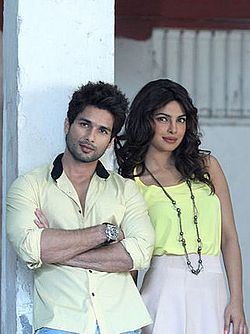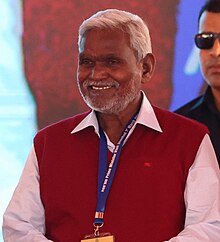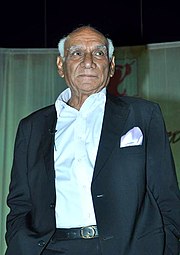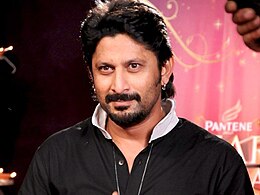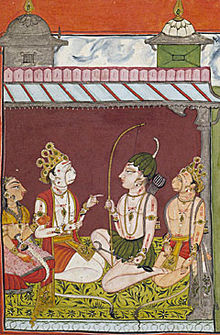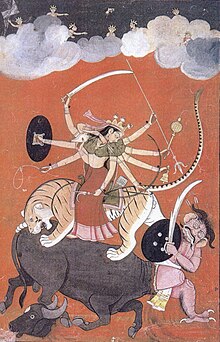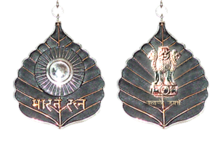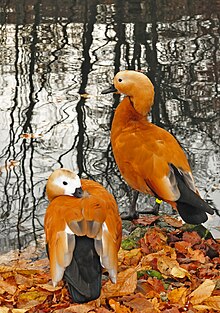Portal:India
Introduction

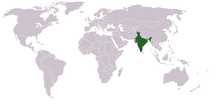
India, officially the Republic of India (ISO: Bhārat Gaṇarājya), is a country in South Asia. It is the seventh-largest country by area; the most populous country as of June 2023; and from the time of its independence in 1947, the world's most populous democracy. Bounded by the Indian Ocean on the south, the Arabian Sea on the southwest, and the Bay of Bengal on the southeast, it shares land borders with Pakistan to the west; China, Nepal, and Bhutan to the north; and Bangladesh and Myanmar to the east. In the Indian Ocean, India is in the vicinity of Sri Lanka and the Maldives; its Andaman and Nicobar Islands share a maritime border with Thailand, Myanmar, and Indonesia. (Full article...)
Selected pictures

Vyāsatīrtha (c. 1460 – c. 1539), also called Vyasaraja or Chandrikacharya, was a Hindu philosopher, scholar, polemicist, commentator and poet belonging to the Madhwacharya's Dvaita order of Vedanta. As the rajaguru of Vijayanagara Empire, Vyasatirtha was at the forefront of a golden age in Dvaita which saw new developments in dialectical thought, growth of the Haridasa literature under bards like Purandara Dasa and Kanaka Dasa and an increased spread of Dvaita across the subcontinent.
He himself composed many kīrtanas in Kannada and Sanskrit.
Three of his polemically themed doxographical works Nyayamruta, Tatparya Chandrika and Tarka Tandava (collectively called Vyasa Traya) documented and critiqued an encyclopaedic range of sub-philosophies in Advaita, Visistadvaita, Mahayana Buddhism, Mimamsa and Nyaya, revealing internal contradictions and fallacies. His Nyayamruta caused a stir in the Advaita community across the country requiring a rebuttal by Madhusudhana Saraswati through his text, Advaitasiddhi. He is considered as an amsha of Prahlada in the Madhva Parampara. (Full article...)
The ruddy shelduck (Tadorna ferruginea), known in India as the Brahminy duck, is a member of the family Anatidae. It is a distinctive waterfowl, 58 to 70 cm (23 to 28 in) in length with a wingspan of 110 to 135 cm (43 to 53 in). It has orange-brown body plumage with a paler head, while the tail and the flight feathers in the wings are black, contrasting with the white wing-coverts. It is a migratory bird, wintering in the Indian subcontinent and breeding in southeastern Europe and central Asia, though there are small resident populations in North Africa. It has a loud honking call.
The ruddy shelduck mostly inhabits inland water-bodies such as lakes, reservoirs and rivers. The male and female form a lasting pair bond and the nest may be well away from water, in a crevice or hole in a cliff, tree or similar site. A clutch of about eight eggs is laid and is incubated solely by the female for about four weeks. The young are cared for by both parents and fledge about eight weeks after hatching. (Full article...)

The Inland Customs Line, incorporating the Great Hedge of India (or Indian Salt Hedge), was a customs barrier built by the British colonial rulers of India to prevent smuggling of salt from coastal regions in order to avoid the substantial salt tax.
The customs line was begun under the East India Company and continued into direct British rule. The line had its beginnings in a series of customs houses established in Bengal in 1803 to prevent the smuggling of salt to avoid the tax. These customs houses were eventually formed into a continuous barrier that was brought under the control of the Inland Customs Department in 1843. (Full article...)
After the release of the commercially and critically successful romantic film Kaho Naa... Pyaar Hai (2000), Roshan wanted to work again with his son Hrithik on a different type of film. In June 2001, during the 2nd IIFA Awards, he announced the second film when he received the Best Director award for Kaho Naa... Pyaar Hai. Principal photography was shot by Ravi K. Chandran and Sameer Arya from November 2001 to March 2003 on sets built by Sharmishta Roy in Canada, India, and New Zealand. Roshan's brother, Rajesh Roshan, composed the film's soundtrack and background score. American artists Mark Clobe and Craig Mumma spent ₹4 crore (US$500,000) on its visual effects. (Full article...)
The film was originally planned to be Aditya Chopra's directorial debut, but it was his second film after Dilwale Dulhania Le Jayenge (1995). Its themes were inspired by those from the 1989 American coming-of-age drama Dead Poets Society. Produced on a budget of more than ₹100 million (US$2.23 million), the principal photography of Mohabbatein, which was filmed in the United Kingdom, was handled by Manmohan Singh between October 1999 and July 2000. Sharmishta Roy and Karan Johar built the sets and designed the costumes, respectively. The duo Jatin–Lalit composed its music while Anand Bakshi wrote the lyrics. (Full article...)
Ranbir Kapoor (pronounced [ɾəɳˈbiːɾ kəˈpuːɾ], born 28 September 1982) is an Indian actor known for his work in Hindi-language films. He is one of the highest-paid actors of Hindi cinema and has featured in Forbes India's Celebrity 100 list since 2012. Kapoor is the recipient of several awards, including seven Filmfare Awards.
The son of actors Rishi Kapoor and Neetu Singh, and the grandson of actor-director Raj Kapoor, Kapoor pursued filmmaking and method acting at the School of Visual Arts and the Lee Strasberg Theatre and Film Institute, respectively. He subsequently assisted Sanjay Leela Bhansali on the film Black (2005) and made his acting debut with Bhansali's tragic romance Saawariya (2007), a critical and commercial failure. He rose to prominence with the coming-of-age film Wake Up Sid, the romantic comedy Ajab Prem Ki Ghazab Kahani (both 2009), and the political drama Raajneeti (2010). (Full article...)
The encyclopedic treatise is structured as five sub-books with a cumulative total of 100 chapters. It is notable for its extensive discussion of arts, particularly music and dance. It is also notable for including chapters on food recipes and festivals, many of which are a part of modern Indian culture. (Full article...)
The film was announced in May 2007 and was the directorial debut of Devgn, who had long wanted to direct a film. He wrote the story, and the screenplay was written by Robin Bhatt, Sutanu Gupta, and Akash Khurana. Principal photography, by Aseem Bajaj, began in India shortly after the film was announced. It was edited by Dharmendra Sharma, and the background score was written by Monty Sharma. The soundtrack was composed by Vishal Bhardwaj, with lyrics by Munna Dhiman. (Full article...)
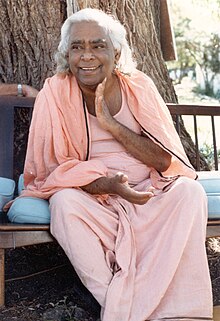
Vishnudevananda Saraswati (31 December 1927 – 9 November 1993) was an Indian yoga guru known for his teaching of asanas, a disciple of Sivananda Saraswati, and founder of the International Sivananda Yoga Vedanta Centres and Ashrams. He established the Sivananda Yoga Teachers' Training Course, possibly the first yoga teacher training programs in the West. His books The Complete Illustrated Book of Yoga (1960) and Meditation and Mantras (1978) established him as an authority on Hatha and Raja yoga. Vishnudevananda was a peace activist who rode in several "peace flights" over places of conflict, including the Berlin Wall prior to German reunification. (Full article...)
Network18 is the holding company of TV18, Web18, Network18 Publishing and Capital18. Through its subsidiaries and franchise licensing agreements, the group owns and operates the news broadcasting networks of News18, and CNBC channels in India, the magazines of Forbes India and Overdrive, the websites of Firstpost and Moneycontrol, and owns various other assets and investments. The broadcasting subsidiary TV18 is the controlling partner in two mass media joint ventures, Viacom18 and AETN18, through which it operates the OTT platforms of Voot, the production house Viacom18 Studios, the television networks of Colors TV, Nickelodeon, Comedy Central, VH1, MTV and the channel History TV18. (Full article...)
AVM Productions wanted to make a film to celebrate their golden jubilee in 1997. The project, which would be titled Minsara Kanavu, was produced by M. Saravanan, M. Balasubramanian, and M. S. Guhan. Menon responded to an advertisement for a director and cinematographer, and made his directorial debut with the film. Venu and Ravi K. Chandran completed the principal photography, and Prabhu Deva choreographed the film. A. R. Rahman composed the soundtrack, which received positive reviews, and the songs "Mana Madurai", "Strawberry", "Thanga Thamarai", and "Vennilave" became popular. (Full article...)
Kripa (Sanskrit: कृप, lit. 'pity', IAST: Kṛpa), also known as Kripacharya (Sanskrit: कृपाचार्य, IAST: Kṛpācārya), is a figure in Hindu mythology. According to the epic Mahabharata, he was a council member of Kuru Kingdom and a teacher of the Pandava and Kaurava princes.
Born to warrior-sage Sharadvan and nymph Janapadi in an extraordinary manner, Kripa and his sister Kripi were adopted by King Shantanu of Kuru Kingdom. Kripa was trained by his birth father and became a great archer like him. Later in the epic, he fought on the Kauravas's side against the Pandavas in the Kurukshetra war and was among the few survivors of the war. (Full article...)
Extremely Severe Cyclonic Storm Giri (IMD designation: BOB 04, JTWC designation 04B, also known as Cyclone Giri) was a powerful tropical cyclone in terms of 1-minute sustained wind speed which caused catastrophic damage in parts of Myanmar in late October 2010. Originating from an area of low pressure over the Bay of Bengal on October 19, the system began as a weak depression 250 km (155 mi) south of Myanmar. Over the following few days, the depression underwent explosive intensification, reaching its peak intensity with winds of 195 km/h (120 mph 3-minute sustained) on October 22. Cyclone Giri made landfall roughly 50 km (31 mi) northwest of Kyaukpyu, shortly after peaking. Within hours of moving onshore, the system had substantially weakened. By the following day, Giri had degenerated into a tropical depression and the final advisory was issued on the storm.
Unlike during Cyclone Nargis in 2008, the Government of Myanmar took steps to ensure the safety of residents in the path of Cyclone Giri. An estimated 53,000 are believed to have evacuated Kyaukphyu before the arrival of the storm. Throughout central Myanmar, at least 157 people are known to have been killed by Giri. Thousands of structures near where the storm made landfall were destroyed, leaving more than 70,000 people homeless. An international relief effort began shortly after the storm passed to assist survivors of the storm. Local and foreign media initially criticized the Myanmar government for not giving residents enough warning of the storm and then for keeping quiet on the situation, but the focus later shifted to the loss of life and relief efforts. (Full article...)
The composition adheres to the pitches of the Indian equivalent of Dorian mode and emulates the khyal vocal tradition of Hindustani classical music. For musical inspiration, Harrison drew from the work of master sitarist Ravi Shankar, who became his sitar tutor shortly after the recording was completed. In its lyrical themes, "Love You To" is partly a love song to Harrison's wife, Pattie Boyd, while also incorporating philosophical concepts inspired by his experimentation with the hallucinogenic drug LSD. In the context of its release, the song served as one of the first examples of the Beatles expressing an ideology aligned with that of the emergent counterculture. (Full article...)
News
- 19 April 2024 – 2024 Indian general election
- Indians begin voting to elect members to the 18th Lok Sabha. There are 969 million people eligible to vote, and voting will continue until June in seven phases. (AP)
- 16 April 2024 – Naxalite–Maoist insurgency
- Indian security forces kill at least 29 Maoist insurgents in a major counterinsurgency operation in Kanker district, Chhattisgarh. A large quantity of weapons are also seized. (NDTV)
- 28 March 2024 – 2023–24 South-West Indian Ocean cyclone season
- Cyclone Gamane makes landfall in Madagascar, killing at least eleven people and causing widespread flooding, according to local officials. (AP)
- 12 March 2024 – Piracy off the coast of Somalia
- About 20 armed pirates hijack a Bangladeshi bulk carrier in the Indian Ocean that was en route to the United Arab Emirates. The vessel is under the control of the pirates and is heading towards the coast of Somalia. (The National News)
- 1 March 2024 –
- At least eight people are injured when a suspected homemade bomb explodes in a cafe in Bengaluru, Karnataka, India. (Reuters)
Did you know...
- ... that Indian cricketer Bangalore Jayaram's English styled Mashie Lodge, was named after his favourite golf club, the Mashie Niblick?
- ... that Jacqueline Kennedy did not want to make her clothes the focus of her 1962 goodwill tour of India and Pakistan, but still wore 22 different outfits in the first nine days?
- ... that the Clock Tower of Haridwar in India provides a good location from which to watch the evening prayers at Har Ki Pauri?
- ... that an Indian maharajah asked Eugenie Grosup to marry him after she received a deportation notice to leave India and return to Nazi-occupied Europe?
- ... that the book Our Hindu Rashtra claims that India is a de facto Hindu-majoritarian state?
- ... that Colonel Hugh Pettigrew observed that troops who thought that the Scottish Highlands resembled Waziristan on India's North West Frontier were "of little use to anyone"?
Timeline of Indian history, Indus Valley Civilisation, Dholavira, Science and technology in ancient India, Meluhha, Aryan invasion theory, Out of India theory, Greek conquests in India, Indian maritime history, Maurya Empire, Ashoka, Shunga Empire, Hoysala Empire, Vijayanagara, Satavahana dynasty, Indo-Greek Kingdom, Indo-Scythians, Indo-Parthian Kingdom, Kushan Empire, Western Satraps, Gupta Empire, Chola dynasty, Pala Empire, Islamic incursions in India, Mughal Empire, Maratha Empire, British Raj, East India Company, Governor-General, Viceroy, War of Independence, 1857, Indian independence movement, Indian National Army, Azad Hind, Quit India Movement, Partition of India, History of Republic of India, Non-Aligned Movement, Sino-Indian War, Indo-Pakistani War of 1947–1948, Indo-Pakistani War of 1965, Indo-Pakistani War of 1971, Kargil War, 2001–02 India–Pakistan standoff, Military, Demographic
Law, Hindu law, Constitution, Political parties (Indian National Congress, Bharatiya Janata Party), Foreign relations, Elections, Political divisions, Reservation in India
Government agencies, Legislative branch (Lok Sabha, Rajya Sabha) Executive branch (President & Vice President, Prime Minister & Deputy Prime Minister, Cabinet Ministers, Cabinet Secretary, Election Commission, Foreign Minister; Law enforcement: CBI, CID, Intelligence: IB, RAW), Directorate General of Income Tax Investigation Judicial branch (Supreme Court), Armed Forces (Army, Navy, Air Force, Border Security Force, Coast Guard)
Himalayas, Western Ghats, Eastern Ghats, Indo-Gangetic Plain, Deccan Plateau, Thar Desert, Ganges, Rann of Kutch, Brahmaputra River, Northeast India; Mountains, Valleys, Islands, Rivers; States and union territories, Cities, Districts, Regions, Fauna, Flora
Rupee, Bombay Stock Exchange, National Stock Exchange, Standard of living, Companies, Reserve Bank of India, Energy policy (Solar, Wind, Nuclear), Tourism, Transport (Expressways, Rail transport, Auto rickshaw),
Languages, Standard of living, Religion
Music (Carnatic, Hindustani, Indi-pop), Dance, Languages, Literature, Architecture, Film & TV, Cuisine, Holidays, Folklore, Education, Media, Indian martial arts
Indian Council of Agricultural Research (ICAR), Indian Institute of Astrophysics, National Centre for Software Technology, AIIMS, IISc, IIT, NIT, BITS-Pilani, INRegistry, Indian numbering system, Indian Space Research Organisation, National Internet Exchange of India, ICRISAT, International Institute of Information Technology, Hyderabad
Indian English, Indian nationality law, Numbering system, Indian Space Research Organisation, Telecommunications, National Highways Development Project, Flag, Vehicle registration plates, Indian nationalism, Metrication in India
Categories
Related portals
Religions in India
Indian Subcontinent
Other countries
Wikipedias in Indian languages
- অসমীয়া (Assamese)
- বাংলা (Bengali)
- भोजपुरी (Bhojpuri)
- বিষ্ণুপ্রিয়া মণিপুরী (Bishnupriya Manipuri)
- गोंयची कोंकणी / Gõychi Konknni (Konkani)
- ગુજરાતી (Gujarati)
- हिन्दी (Hindi)
- ಕನ್ನಡ (Kannada)
- कॉशुर/كشميري (Kashmiri)
- मैथिली (Maithili)
- മലയാളം (Malayalam)
- मराठी (Marathi)
- नेपाली (Nepali)
- नेपाल भाषा
- (Newari)
- ଓଡ଼ିଆ (Odiya)
- ਪੰਜਾਬੀ (Punjabi)
- पालि (Pali)
- संस्कृत (Sanskrit)
- ᱥᱟᱱᱛᱟᱲᱤ (Santali)
- سنڌي (Sindhi)
- தமிழ் (Tamil)
- తెలుగు (Telugu)
- ತುಳು (Tulu)
- اردو (Urdu)
Associated Wikimedia
The following Wikimedia Foundation sister projects provide more on this subject:
-
Commons
Free media repository -
Wikibooks
Free textbooks and manuals -
Wikidata
Free knowledge base -
Wikinews
Free-content news -
Wikiquote
Collection of quotations -
Wikisource
Free-content library -
Wikiversity
Free learning tools -
Wikivoyage
Free travel guide -
Wiktionary
Dictionary and thesaurus


















































